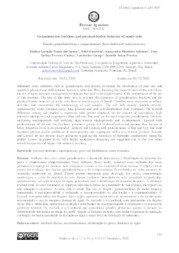Granulometric fractions and physical-hydric behavior of sandy soils.
Granulometric fractions and physical-hydric behavior of sandy soils.
Author(s): SANTOS, N. G. N. dos; OLSZEVSKI, N.; SALVIANO, A. M.; CUNHA, T. J. F.; GIONGO, V.; PEREIRA, J. S.
Summary: Soils attributes such as granulometry and density determine the distribution of pore size and condition physical and differentiated hydraulic behavior. Thus, knowing the characteristics of the soils allow the use of more adequate management techniques that lead to the improvement of the performance of the use of this resource. The aim of this study was to evaluate the diameters of granulometric fractions and the physical-hydric behavior of sandy soils from semiarid region of Brazil. Trenches were excavated to collect, describe, and characterize the morphology of soil samples. The soil bulk density, particle density, granulometry, water retention curve, total porosity and pore size distribution were evaluated. The textural difference among soil studied is expressed with greater emphasis on the amount of macropores, high retention micropores and cryptopores. Fine and very fine sand are the most impacted granulometric fractions increasing macroporosity and reducing high tension microporosity and cryptoporosity. Luvisol with predominance of silt and clay fractions, presents a greater risk of densification and erosion, thus the use of lower irrigation levels is recommended. Acrisols and Luvisol, with predominance of fine and very fine sand fractions, present similar conditions of macroporosity and cryptopores with a low textural gradient. Acrisols and Luvisol do not present major problems regarding the reduction of hydraulic conductivity along the rofile. Lower irrigation levels with higher application frequency are suggested due to the low water retention capacity and higher risk nutrients leaching.
Publication year: 2019
Types of publication: Journal article
Unit: Embrapa Semi-arid Region
Observation
Some of Embrapa's publications are published as ePub files. To read them, use or download one of the following free software options to your computer or mobile device. Android: Google Play Books; IOS: iBooks; Windows and Linux: Calibre.
Access other publications
Access the Agricultural Research Database (BDPA) to consult Embrapa's full library collection and records.
Visit Embrapa Bookstore to purchase books and other publications sold by Embrapa.

